-
Categories
-
Pharmaceutical Intermediates
-
Active Pharmaceutical Ingredients
-
Food Additives
- Industrial Coatings
- Agrochemicals
- Dyes and Pigments
- Surfactant
- Flavors and Fragrances
- Chemical Reagents
- Catalyst and Auxiliary
- Natural Products
- Inorganic Chemistry
-
Organic Chemistry
-
Biochemical Engineering
- Analytical Chemistry
-
Cosmetic Ingredient
- Water Treatment Chemical
-
Pharmaceutical Intermediates
Promotion
ECHEMI Mall
Wholesale
Weekly Price
Exhibition
News
-
Trade Service
Chronic renal failure is the common outcome of the continuous progression of various chronic kidney diseases, and the chronic progressive renal physical damage caused by various causes cannot maintain the basic function of the kidneysIn the period of chronic renal disease uremia, most patients need renal replacement therapy, which will inevitably cause changes in the internal environment of patientsIf such patients require surgery due to the disease, the risk of surgery and anesthesia will be greatly increasedA pregnant woman who was admitted to the hospital in 2017 with chronic kidney failure, the anaesthetic treatment is as follows1clinicalinformation and methodspatients, female, 31 years old, height 162 cm, weight 68 kg, 2 birth 0, stopped for 34 5/7 weeks, now due to vaginal discharge 5h, abdominal pain requirements to be admitted to hospital for deliveryPast history: three years agodiagnosedwith IgA nephropathy (
vascularsource type), chronic kidney disease 5 stage,hemolysisdialysis treatmentAnemia, high blood pressure , denial of heart disease, and diabetes A week ago appeared chest tightness, wheezing, sitting breathing and other symptoms, diagnosis heart failure, heart function III-IV echocardiogram shows: the left heart is increased, and the left ventricular contraction function decreases (EF38%) Laboratory examination: myocardial marker: myoglobin 69.2 ng/ml Coagulation routine: fibrin protodegrado degradation product 8.5 ?g/ml, fibrin progenitor determination: 6.22 g/ml, D-dipolymer 2.59 ?g/ml, anticoagulase 132% Hepatocosic and renal work, ions, myocardial enzymes: urea nitrogen 10.24mmol/L, uric acid 267?mol/L carinininininine 550?mol/L, B-type sodium urea peptide 704pg/ml Blood routine: total white blood cells 10.4 x 109/L, hemoglobin 97g/L pre-anaesthetic monitoring: after entering the room to take the left side lycdown upper body raised, give the mask pressure to absorb oxygen, in 1% Lidoca in local anesthesia, and give the patient language comfort, make it relax, and then line the artery and the right side of the neck venous puncture tube Connect the Flotrac/Vigilo monitoring system (Ed-wards) Continuous monitoring includes traumatic blood pressure, cardiac output (CO), per-fight variability (SVV), CVP, electrocardiogram, and SpO2 in-room display: SpO2:87%, HR:110-130bpm, BP:187/112mmHg, breathing 30-35 times/min, shortness of breath, rapid establishment of two vein channels, respectively, slow infusion of hydroxythyl starch solution, physiological saline Anesthetic mode: lumbar joint anesthesia, anaesthetic puncture body position to take the left sleeper piercing, puncture gap to take L2-L3, after the successful puncture, through the lumbar puncture needle injected into the cobweb subcavity 0.75% weight ratio length of 1 ml, slow push, and to the head end of the membrane permeation tube 3.5 cm, control anesthesia plane in T8 below, anaesthetic effect the effect of anesthesia after the effect of the left side, head side are raised 15-20 degrees, in order to prevent the emergence of reclining hypotension syndrome Ephedrine is given 10 mg immediately after the puncture to prevent the occurrence of hypotension after intravertebral anaesthetic After giving with 4 sg/ml denopinephrine 12 sg, waist after the minimum blood 100/57mmHg At the same time, the neonatologist and cardiologists are invited to participate in mother and child rescue The operation continued to use Sedilands 0.2-0.4mg, dopamine 3-4 sg/kg, speed urine 20 mg When the central vein pressure is higher than 20 cmH2O, the central vein pressure is treated with 20 mg of nitroglycerin intravenous drip blood vessel the first 5min of fetal head delivery, blood pressure control at 120-100/75-60mmHg During the delivery of the birth of the obstetrician slowly release amniotic fluid, slowly remove the fetus, after the blood pressure instantly as low as 89-70/59-45mmHg, then continue to intermittently give ephedrine 10mg, norepinephrine 8 sg static pressure control blood pressure, mask pressure Oxygen absorption, post-blood pressure between 130-120/75-65mmHg, HR 85-95 times/min, SpO2 93%-95%, CVP 11-18mm Hg, strictly control the infusion speed Surgical time of 40min, after the fetus removed 10-15min, the maternal heart failure symptoms improved significantly, SpO2 rose to 95%-97%, HR 120 times / minute, CVP reduced to 8-12 cmH2O, the input crystal fluid 100 ml, colloidal fluid 100, urine volume of 50 ml The blood gas analysis of the operation, the indicators are normal 5min neonatal Apgar scored 8.5 points and continued to observe treatment in the neonatal unit After the operation using PCEA analgesia, after the operation the mother sent me to the hospital ICU to continue treatment Patients are clearly aware of the ICU, BP135/92mmHg, HR 89 times/min, RR30/min, SpO2 97% The patient has no obvious discomfort and no pain The patient was discharged four days later, but continued on dialysis 2 Discussion of renal insufficiency patients in pregnancy due to the relative increase in blood volume, renal function caused by water and electrolyte metabolic retention often appear heart dysfunction, as in this case patients, for such maternal anaesthetic method selection and management is very important, such patients have higher anaesthetic requirements, should minimize the occurrence of pain stimulation and excessive pull in surgery to avoid center of gravity failure the choice of anesthesia: the introduction of general anaesthetic can lead to renal failure patients kidney blood flow reduction, up to 50%, drug removal rate, action time, drug effect intensity will be affected accordingly In addition, the rise reaction when intubation can also cause violent fluctuations in blood pressure, thus adding to the decline of the center of gravity, so try to avoid lumbar: epidural joint anesthesia downstream caesarean section by reducing the excitability of the sympathetic nerve, reducing the oxygen consumption of the heart, dilating peripheral blood vessels, reducing the amount of blood back, reducing the front and rear load of the heart Compared with simple epidural anesthesia, the amount of anesthesia is less, the effect is rapid and accurate and so on However, the anaesthetic plane is difficult to control, blood flow dynamic fluctuations, the incidence of low blood pressure is higher, serious cases can cause heart rate slowdown, nausea, vomiting, may aggravate the disease Anesthesia can be by taking the head high left side under the slowly injection, slow down the injection speed, give blood vessel active drugs, wait for the anaesthetic effect to be perfected after the slow release of the operating table However, it is necessary to pay special attention to the patient's long-term heparin hemolysis dialysis treatment, before choosing lumbar vertebral tube anesthesia must pay attention to the blood clotting function of the examination Liquid management patients with uremia, overdosing intravenous fluids and over-expansion of extracellular capacity should be avoided, and electrolyte and acid-base states should be maintained or corrected By monitoring CVP, SVV rehydration Capacity-expanding therapy is performed under the guidance of SVV 13%, and if SVV is 13%, the hydroxyethyl starch injection is slowly infusion In prevention of low blood pressure reaction during the lumbar hemp, colloidal is relatively ideal, but relying solely on rapid pre-infusion colloidal still has the possibility of causing pulmonary edema, especially in patients with limited cardiopulmonary function This case patient suffers from severe heart failure and kidney failure, circulating overload, and not easy to import liquid too quickly too much, so this method is not desirable The liquid input should be strictly controlled while ensuring the stability of the cycle preoperative preparation to be full, ready for the appropriate model of maternal and newborn full hemp intubation package, visual laryngoscope, vascular active drugs (dopamine, nitroglycerin nitrate, norepinephrine, epinephrine, Western landland), if necessary, for full hemp intubation and rescue should focus on the fetal delivery of this time period, because the fetus after delivery of abdominal pressure plummeted, uterine contraction in the uterine sinus of blood about 500 ml suddenly into the body circulation, greatly aggravated the burden of the heart, will cause serious heart failure When removing the fetus, it is important to release amniotic fluid slowly, and after the fetus is removed, it can be prevented by increasing the negative pressure should be given effective analgesic treatment, such as PCEA analgesia, to reduce the stress response caused by pain Women with chronic kidney disease combine pregnancy, but can aggravate the original kidney disease and even lead to kidney failure For patients with chronic kidney disease in pregnancy, the pregnancy should be treated early and even terminated in due course, if necessary, choose to use kidney replacement therapy The treatment of combined renal failure during pregnancy is difficult, has great effect on the fetus, has many complications, has difficulty in prognosis, and effectively prevents the combined kidney function during pregnancy is not the best method at present







